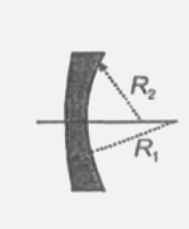If two thin lenses are kept coaxially together, then their power is proportonal (R1,R2being the radii of curved surfaces) to Solution in Tamil
R1+R2
[R1+R2R1R2]
[R1R2R1R2]
none of these
The correct Answer is:A, B
P=1f1+1f2=2R1+2R2=2(R1+R2R1R2)orp≈(R1+R2R1R2)
Topper's Solved these Questions
- BOOK - FULL MARKSCHAPTER - OPTICSEXERCISE - ADDITIONAL QUESITON - II ADDITIONAL PROBLEMS:11videos
OPTICS
- BOOK - FULL MARKSCHAPTER - OPTICSEXERCISE - TEXTUAL EVALUATION SOLVED V.NUMERICAL PROBLEMS10videos
OPTICS
- BOOK - FULL MARKSCHAPTER - MAGNETISM AND MAGNETIC EFFECTS OF ELECTRIC CURRENT EXERCISE - ADDITIONAL QUESTIONS SOLVED - NUMERICAL PROBLEMS :4videos
MAGNETISM AND MAGNETIC EFFECTS OF ELECTRIC CURRENT
- BOOK - FULL MARKSCHAPTER - RECENT DEVELOPMENTS IN PHYSICSEXERCISE - ADDITIONAL QUESTIONS (Short Answer Question)6videos
RECENT DEVELOPMENTS IN PHYSICS
Similar Questions
Light from a point source in air falls on a spherical glass surface (n = 1.5 and radius of curvature = 20 cm ). The distance of the light source from the glass surface is 100 cm. At what position the image is formed ?
View SolutionAn object is placed at a certain distance from a convex lens of focal length 20 cm. Find the distance of the object if the image obtained is. magnified 4 times.
02:08View SolutionThe radius of the first orbit of hydrogen atom is 0.5 Å. The electron moves is an orbit with a uniform speed of 2.2×106ms−1. What is the magnetic field produced at the centre of the uncleus due to the mation of this electron ? Use μ0=4π×10−7Hm−1 and electric charge =1.6×10−19 C
05:35View SolutionWhat is physics?
02:54View SolutionWhich one of the following sperical lenses does not exhibit dispersion? The radii of curvature of the surfaces of the lenses are as given in the diagrams.
R1≠R203:02View SolutionTwo spherical black bodies of radii R1 and R2 and with surface temperature T1 and T2 respectively radiate the same power. R1/R2 must be equal to
02:20View SolutionThe capacitance of two concentric spherical shells of radii R_(1) and R_(2) (R_(2) gt R_(1)) is
01:13View SolutionThe curved surface area of frustum of a cone is π/(r1+r2), where l=√h2+(r1+r2)2,r1andr2 are the radii of two ends of the frustum and h s the vertical height.
View Solutionसाबुन के दो बुलबले जिनके त्रिज्याएँ r1 व r2(r1>r2) है , मिलकर एक हो जाते है । उनके उभयनिष्ठ पृष्ठ की त्रिज्या R होगी :
02:27View SolutionTwo Cu wires of radii R1 and R2 are such that (R1>R2) . Then which of the following is true ?
02:06View SolutionIf R1andR2 are the radii of curvature of the spherical surfaces of a thin lens and R1>R2, then this lens can
 02:40View Solution
02:40View SolutionTwo soap bubbles of radii R1andR2 kept in atmosphere are combined isothermally to form a big bubble of radius R. The expression for surface tension will be
03:36View SolutionTwo spherical black bodies of radii r1 and r2 and with surface temperatures T1 and T2 respectively, radiate the same power. Then r1/r2 must be equal to
05:27View SolutionTwo satellites of radii r_(1) and r_(2) are made from the same material.The ratio of acceleration due to gravities at the surface of the two satellites is (A) (r_(1))/(r_(2)) (B) (r_(2))/(r_(1)) (C) (r_(1)^(2))/(r_(2)^(2))
01:24View SolutionThe curved surface area of frustum of a cone is π/(r1+r2), where l=√h2+(r1+r2)2,r1andr2 are the radii of two ends of the frustum and h s the vertical height.
01:52View Solution

